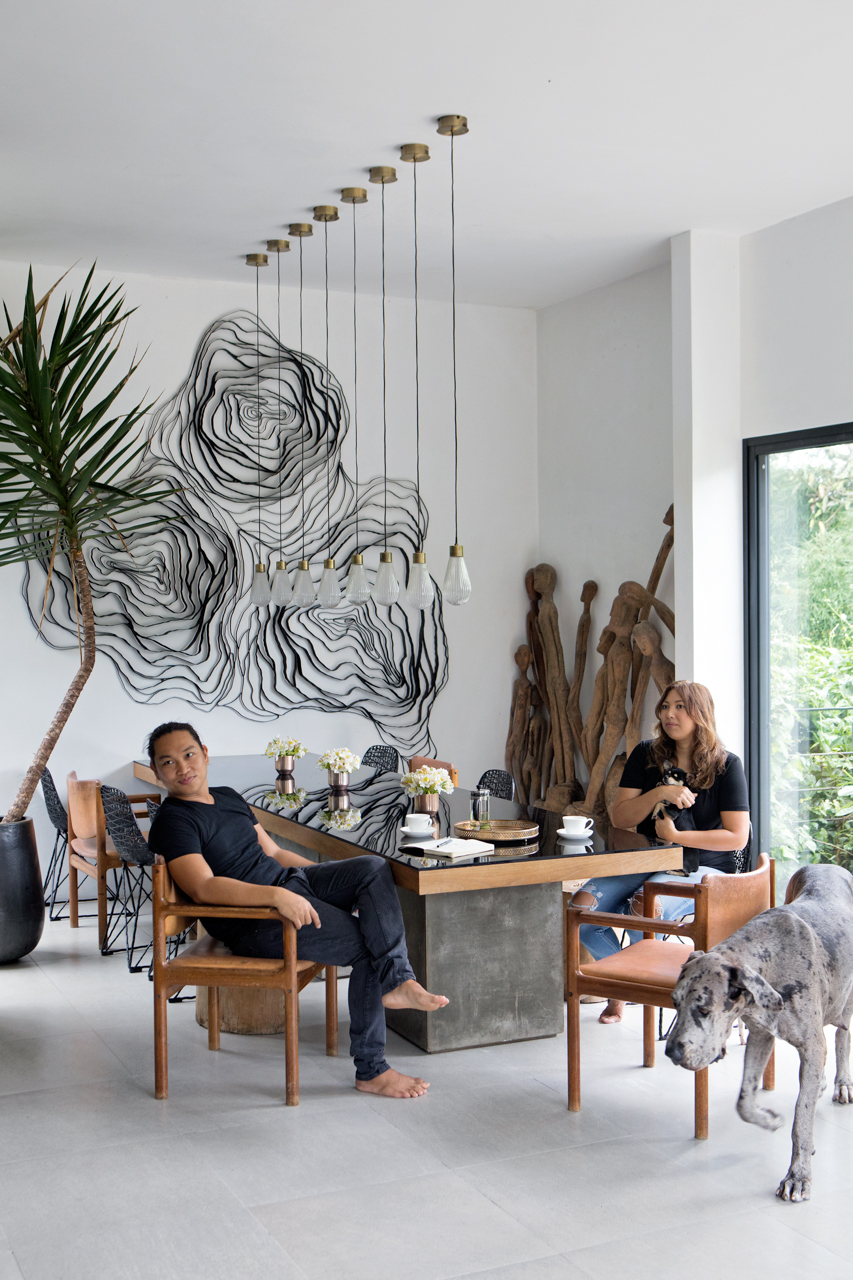In the space he calls home, Jinggoy Buensuceso’s personal abode is the stuff of dreams.
Covered in bulrushes and bamboo shoots, the expanse of a black wall is broken at the center by a rusted metal gate that towers over onlookers; a cacophony of barks and howls greets visitors whenever it opens. Concrete black boxes are given life with vast glass windows and organic elements here and there: foliage on one side, wooden details on another. This is the Buensuceso house, home to visual artist and designer Jinggoy Buensuceso, his wife and Luxasia country manager Mutya, their two children, 25 dogs, 16 cats, three civets, a few piglets, two bunnies, a rescued owl, and during the day, a full team of carpenters and personnel. We’re sure this list goes on.

Lines into layers
The massive 1,000-sq.m. lot comes in tiers—an intelligent layout among the hillside homes that line Tagaytay’s cliffs. “We respect the contour of the terrain,” Buensuceso says as he tours us through the different levels of the compound. Having lived right beside the Singapore Botanic Gardens before, the couple was spoiled by the lush greenery and abundant fauna of a tropical garden and aimed to live the same way in the Philippines, away from the toxicities of city life. Their desire was translated into this respite amid nature, hidden from the rest of the world.
“This house is not going to finish soon. It’s still evolving.” Whirrs of drilling and the clatter of hammering is heard along with the chirping of birds and the clucking of fowl; it all creates an unfamiliar yet harmonious composition. The home itself has its own metaphor, as imagined by Buensuceso: built piece by piece, “like a giant block of stone, [and] then plants started to grow.” As straight, manmade lines of the rigid structure coincide with the organic shapes of the natural landscape, harmony is evident in the balance of variant geometries.
Opposing forces
Buensuceso’s art form is distinctive. “I combine the simplest form of art and design, which is [the] line.” In his workshop out back, he showcases his creations. Filled with contradicting elements, each work is a paradox, like the silver clock made of molten aluminum that indicates a coarse texture despite the sheen of metal. This contrast applies to the house as well, where most of his artworks find sanctuary. “A lot of my pieces are composed of two things: the push and pull, the organic and contemporary.”
“A lot of my pieces are composed of two things: the push and pull, the organic and contemporary.”
Jinggoy Buensuceso
Buensuceso admits that he is the happiest at home. And why not? It seems to exist within the fine line between the interiors and the exteriors: verdant plants indoors complement the view of the forest outside, vibrant insects fly in and out, and the family’s motley crew of Great Danes and Chihuahuas lounge around on faux fur carpets. “The house is composed of lines. Different boxes are put together for different spaces.”
Infinite canvas
“The look of the black house [and] this natural environment always gives me inspiration,” Buensuceso says. With so much room to breathe in his personal space, he “always sees the beauty in the organic.” Surrounded by nature, the artist reverts to the basics. “I see the organic form of nature and translate them into lines. Everything is made of lines.”
The surrounding homes feature wooden or neutral-colored walls to blend in with the forests. A stark contrast to the rustic abodes in the area, the Buensuceso home is painted black. “Black is an infinite canvas for inspiration.” In the midst of the absence of color, the Buensucesos add their own palette of creativity. Jinggoy adds that the family is very relaxed with the color black as he describes it as “very peaceful.”
On this canvas of a home they are continually growing, Jinggoy and Mutya are raising their children among the trees and the animals. “It takes a lot from parents,” Mutya explains the home dynamics. “They expect attention. They always have activities but the good things outweigh [everything else].” Retrogressing to the basics with their own children, the latter are exposed to more of the outdoors, storytelling, and the fundamentals of fun. It is a simple concept that proves essential in every human—getting back in touch with your roots.
This story originally appeared in Southern Living, August 2017.
Read more:
Photographer Koji Arboleda practices minimalism at his new home
One/Zero finds its haven in Escolta
Jay Taruc puts up an art space of his own
The secret to a well-designed space is a skill in carpentry